如何在 Flutter 中實(shí)現(xiàn) 2D 可滾動(dòng)的表格,探索 Flutter 中的二維可滾動(dòng)項(xiàng),表格解決方案
背景
表格是在應(yīng)用程序中高效組織數(shù)據(jù)的有用工具。Flutter 的最新更新引入了 TwoDimensionalScrollView 小部件。
TwoDimensionalScrollView 是一個(gè)小部件,它結(jié)合了 TwoDimensionalScrollable 和 TwoDimensionalViewport 在垂直和水平維度上創(chuàng)建內(nèi)容的交互式滾動(dòng)窗格,但直接使用它有點(diǎn)具有挑戰(zhàn)性。
下面是在 Flutter 中實(shí)現(xiàn) 2D ScrollView 的演示代碼。
介紹
Flutter 的預(yù)構(gòu)建 widget 具有出色的性能,僅當(dāng)子視圖位于視圖中時(shí)才延遲渲染子視圖,從而提高了性能,但 Flutter 發(fā)布了一個(gè)新包 two_dimensional_scrollables 來實(shí)現(xiàn)在垂直軸和水平軸上滾動(dòng)的 TableView。
在本教程中,我們將探索這個(gè)包來實(shí)現(xiàn)一個(gè)非常簡單的 Tableview,并了解如何自定義它。
您可以在這里[1]找到完整的源代碼。
執(zhí)行
添加依賴項(xiàng)
要添加依賴項(xiàng),請(qǐng)首先打開 pubspec.yaml 文件,然后添加依賴項(xiàng)。
dependencies:
two_dimensional_scrollables: <latest version>將 TableView 添加到屏幕
添加 TableView 時(shí),可以使用兩個(gè)構(gòu)造函數(shù):
- TableView.list :這個(gè)與 Flutter 的 ListView 類似。它一次添加所有單元格,并且適用于較短的列表。
- Tableview.builder :當(dāng)視圖進(jìn)入視口時(shí),它會(huì)延遲添加子項(xiàng)。非常適合您不想一次加載所有內(nèi)容的較大列表!
讓我們創(chuàng)建一個(gè)簡單的 Tableview 來顯示以下信息。
class Employee {
final String id;
final String name;
final String role;
final String email;
Employee({
required this.id,
required this.name,
required this.role,
required this.email});
static get getEmployees{
return [
Employee(id: '1', name: 'John Doe', role: 'Manager', email: 'john@example.com'),
Employee(id: '2', name: 'Jane Smith', role: 'Developer', email: 'jane@example.com'),
Employee(id: '3', name: 'Mike Johnson', role: 'Designer', email: 'mike@example.com'),
Employee(id: '4', name: 'Emily Brown', role: 'HR Specialist',email: 'emily@example.com'),
Employee(id: '5', name: 'Alex Lee', role: 'Marketing Analyst', email: 'alex@example.com'),
Employee(id: '6', name: 'John Doe', role: 'Manager', email: 'john@example.com'),
Employee(id: '7', name: 'Jane Smith', role: 'Developer', email: 'jane@example.com'),
Employee(id: '8', name: 'Mike Johnson', role: 'Designer', email: 'mike@example.com'),
Employee(id: '9', name: 'Emily Brown', role: 'HR Specialist',email: 'emily@example.com'),
Employee(id: '10', name: 'Alex Lee', role: 'Marketing Analyst', email: 'alex@example.com'),
];
}
}這是 TableView.builder 的基本示例代碼。
class TwoDimensionalScrollableDemo extends StatelessWidget {
TwoDimensionalScrollableDemo({super.key});
final List<Employee> employees = Employee.getEmployees;
@override
Widget build(BuildContext context) {
return Scaffold(
appBar: AppBar(
title: const Text("Table view Demo"),
),
body: TableView.builder(
columnCount: 2,
rowCount: 11,
columnBuilder: buildTableSpan,
rowBuilder: buildTableSpan,
cellBuilder: (BuildContext context, TableVicinity vicinity) {
return Container(child: Center(child: addText(vicinity)));
}),
);
}
TableSpan buildTableSpan(int index){
return TableSpan(extent: FixedTableSpanExtent(50));
}
Widget addText(TableVicinity vicinity) {
if (vicinity.yIndex == 0 && vicinity.xIndex == 0) {
return const Text("Index");
} else if (vicinity.yIndex == 0 && vicinity.xIndex == 1) {
return const Text("name");
} else if (vicinity.xIndex == 0) {
return Text(employees[vicinity.yIndex-1].id);
} else if (vicinity.xIndex == 1) {
return Text(employees[vicinity.yIndex-1].name);
}
return Text("");
}
}這對(duì)于幾行代碼來說已經(jīng)相當(dāng)不錯(cuò)了,讓我們分解一下 TableView.builder 所需的參數(shù)。
- columnCount :該參數(shù)設(shè)置表中的列數(shù)。
- rowCount :該參數(shù)設(shè)置表中的行數(shù)。
- columnBuilder :它是一個(gè)幫助定義表中每列的布局和功能的函數(shù)。它接受一個(gè)整數(shù)作為參數(shù),并返回一個(gè) TableSpan ,它構(gòu)造和配置列。
- rowbuilder :與 columnBuilder 類似,此函數(shù)定義 TableView 中每行的布局和行為。
- cellBuilder :它處理表中每個(gè)單元格的布局。它采用 TableVicinity 參數(shù),其中包含特定單元格的行索引和列索引。這有助于您自定義表格中各個(gè)單元格的外觀和行為。
運(yùn)行上面的代碼,您將看到以下輸出。
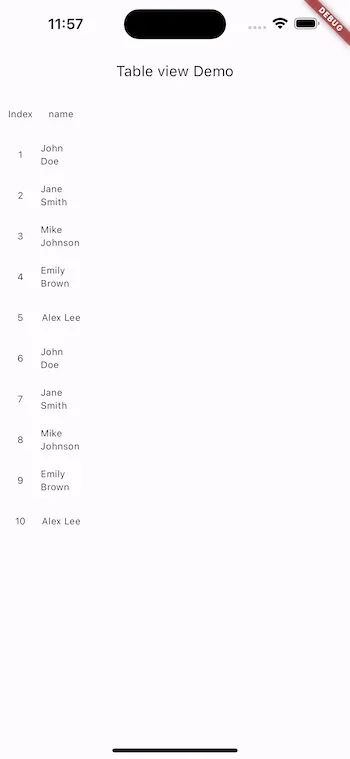 圖片
圖片
現(xiàn)在,讓我們研究一下 TableView.builder 提供的功能!那么,讓我們看看如何自定義和控制 TableView 并添加更多功能。
TableSpan 表跨度
TableSpan 表示 TableView 中的一行或一列。
添加邊框
TableSpan buildTableSpan(int index) {
TableSpanDecoration decoration = const TableSpanDecoration(
border: TableSpanBorder(
trailing: BorderSide(color: Colors.black),
leading: BorderSide(color: Colors.black)));
return TableSpan(
extent: const FixedTableSpanExtent(100),
foregroundDecoration: decoration);
}TableSpanDecoration 類用于指定 TableSpan 的裝飾。我們可以通過 TableSpanBorder 類中的 border 參數(shù)為 TableSpan 添加邊框,該類具有代表行左右邊框和列上下邊框的拖尾和前導(dǎo)屬性。
添加顏色
TableSpan buildTableSpan(int index) {
TableSpanDecoration decoration = TableSpanDecoration(
color: index == 0 ? Colors.grey[300] : null,
border: const TableSpanBorder(
trailing: BorderSide(color: Colors.black),
leading: BorderSide(color: Colors.black)));
return TableSpan(
extent: const FixedTableSpanExtent(100),
backgroundDecoration: decoration);
}TableSpanDecoration 中的 color 屬性用于設(shè)置 TableSpan 的顏色。
運(yùn)行代碼,輸出將如下所示
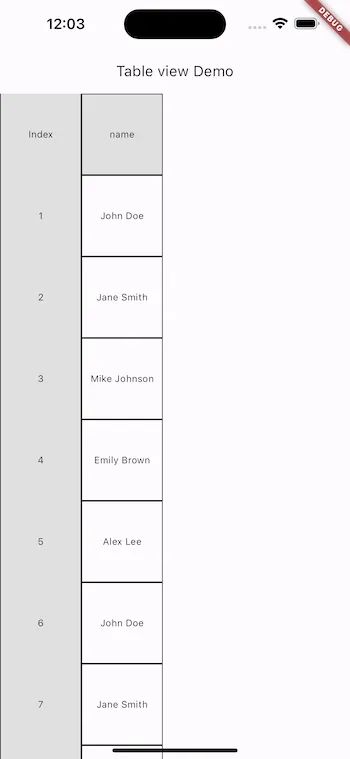 圖片
圖片
因?yàn)?/p>
- 在 TableView 中,裝飾按特定順序繪制。
- 首先繪制 mainAxis 的 backgroundDecoration (作為主軸的行或列)。
- 然后,繪制其他軸上的裝飾。
- 接下來,繪制跨度內(nèi)的各個(gè)單元格內(nèi)容。
- 最后,任何指定的 foregroundDecoration 都會(huì)繪制在內(nèi)容之上。
這里默認(rèn)的軸是 Axis.vertical ,所以,先繪制列,然后繪制行,邊框與行裝飾重疊,所以,讓我們?yōu)榍熬把b飾添加邊框。
TableSpan buildTableSpan(int index) {
TableSpanDecoration foreGroundDecoration = const TableSpanDecoration(
border: TableSpanBorder(
trailing: BorderSide(color: Colors.black),
leading: BorderSide(color: Colors.black)));
TableSpanDecoration backGroundDecoration = TableSpanDecoration(
color: index == 0 ? Colors.grey[300] : null,
);
return TableSpan(
extent: const FixedTableSpanExtent(100),
backgroundDecoration: backGroundDecoration,
foregroundDecoration: foreGroundDecoration);
}在前景裝飾中添加邊框可確保其呈現(xiàn)在 TableView 中單元格內(nèi)容的頂部。
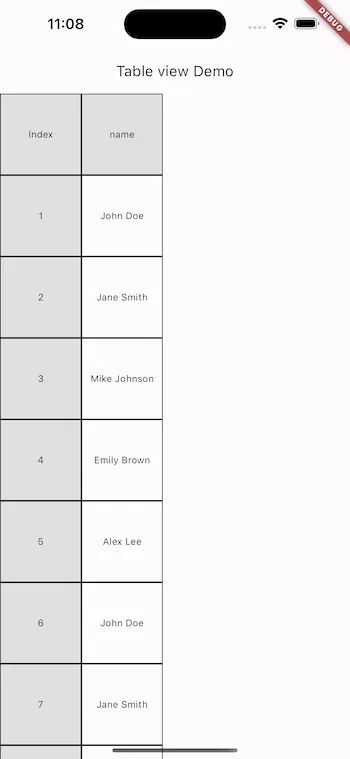 圖片
圖片
TableSpan.extent
它表示行的高度和列的寬度,TableSpanExtent 有四種類型。
1.FixedTableSpanExtent
具有固定[像素]的跨度。
extent: const FixedTableSpanExtent(50), 圖片
圖片
2.FractionTableSpanExtent
它將跨度范圍指定為視口范圍的一部分。它與 Expanded 小部件相同,根據(jù)提供的分?jǐn)?shù)占用空間。
extent: const FractionalTableSpanExtent(0.5), 圖片
圖片
3.RemainingTableSpanExtent
它指定跨度應(yīng)占據(jù)視口中的剩余空間。
TableSpan buildColumnSpan(int index) {
TableSpanDecoration decoration = const TableSpanDecoration(
border: TableSpanBorder(
trailing: BorderSide(color: Colors.black),
leading: BorderSide(color: Colors.black)));
return TableSpan(
extent: index==0? FixedTableSpanExtent(100):RemainingTableSpanExtent(), backgroundDecoration: decoration);
} 圖片
圖片
4.CombiningTableSpanExtent
它以兩個(gè)范圍作為參數(shù),并通過組合器函數(shù)運(yùn)行這兩個(gè)范圍的結(jié)果。
TableSpan buildRowSpan(int index) {
TableSpanExtent extent1 = FixedTableSpanExtent(100);
TableSpanExtent extent2 = FixedTableSpanExtent(100);
double combiner(double value1, double value2) {
return value1 + value2;
}
TableSpanDecoration foreGroundDecoration = const TableSpanDecoration(
border: TableSpanBorder(
trailing: BorderSide(color: Colors.black),
leading: BorderSide(color: Colors.black)));
TableSpanDecoration backGroundDecoration = TableSpanDecoration(
color: index == 0 ? Colors.grey[300] : null,
);
if (index == 1) {
return TableSpan(
extent: CombiningTableSpanExtent(extent1, extent2, combiner),
backgroundDecoration: backGroundDecoration,
foregroundDecoration: foreGroundDecoration);
}
return TableSpan(
extent: const FixedTableSpanExtent(100),
backgroundDecoration: backGroundDecoration,
foregroundDecoration: foreGroundDecoration);
} 圖片
圖片
當(dāng)鼠標(biāo)指針(按下或不按下按鈕)進(jìn)入此跨度描述的行或列時(shí)觸發(fā)。
void Function(PointerEnterEvent)? onEntervoid Function(PointerExitEvent)? onExit
當(dāng)鼠標(biāo)指針(按下或未按下按鈕)退出此跨度描述的行或列時(shí),它會(huì)觸發(fā)。
void Function(PointerExitEvent)? onExitrecognizerFactories
recognizerFactories: <Type, GestureRecognizerFactory>{
TapGestureRecognizer:
GestureRecognizerFactoryWithHandlers<TapGestureRecognizer>(
() => TapGestureRecognizer(),
(TapGestureRecognizer t) {
t.notallow=(TapDownDetails tapdownDetails){
print(tapdownDetails.localPosition);
};
t.notallow=(TapUpDetails tapupDetails){
print(tapupDetails.localPosition);
};
}
),
},recognizerFactories 是一個(gè)映射,其中鍵是手勢(shì)類型,值是 GestureRecognizerFactory 的實(shí)例。
GestureRecognizerFactoryWithHandlers 有兩個(gè)參數(shù)。調(diào)用時(shí)返回 TapGestureRecognizer 實(shí)例的函數(shù)和初始化 TapGestureRecognizer 并設(shè)置事件處理程序以處理特定事件詳細(xì)信息的回調(diào)函數(shù)。
添加填充
padding 屬性用于為每行和每列添加填充。
padding: TableSpanPadding(leading: 10),向 UI 添加更多列和行
讓我們?cè)?TableView 中顯示來自 Employee 類的更多數(shù)據(jù),例如 email 和 role 。
Widget addText(TableVicinity vicinity) {
if (vicinity.yIndex == 0 && vicinity.xIndex == 0) {
return const Text("Index");
} else if (vicinity.yIndex == 0 && vicinity.xIndex == 1) {
return const Text("name");
} else if (vicinity.yIndex == 0 && vicinity.xIndex == 2) {
return const Text("Email");
} else if (vicinity.yIndex == 0 && vicinity.xIndex == 3) {
return const Text("Role");
} else if (vicinity.xIndex == 0) {
return Text(employees[vicinity.yIndex - 1].id);
} else if (vicinity.xIndex == 1) {
return Text(employees[vicinity.yIndex - 1].name);
} else if (vicinity.xIndex == 2) {
return Text(employees[vicinity.yIndex - 1].email);
} else if (vicinity.xIndex == 3) {
return Text(employees[vicinity.yIndex - 1].role);
}
return Text("");
}
...
body: TableView.builder(
mainAxis: Axis.horizontal,
columnCount: 4,
rowCount: 21,
columnBuilder: buildColumnSpan,
rowBuilder: buildTableSpan,
cellBuilder: (BuildContext context, TableVicinity vicinity) {
return Center(child: addText(vicinity));
}),
...
TableSpan buildColumnSpan(int index) {
TableSpanDecoration decoration = const TableSpanDecoration(
border: TableSpanBorder(
trailing: BorderSide(color: Colors.black),
leading: BorderSide(color: Colors.black)));
if (index == 2) {
return TableSpan(
extent: const RemainingTableSpanExtent(),
backgroundDecoration: decoration,
);
} else if (index == 3) {
return TableSpan(
extent: const FractionalTableSpanExtent(0.5),
backgroundDecoration: decoration,
);
}
return TableSpan(
extent: FixedTableSpanExtent(100), backgroundDecoration: decoration);
}輸出是:
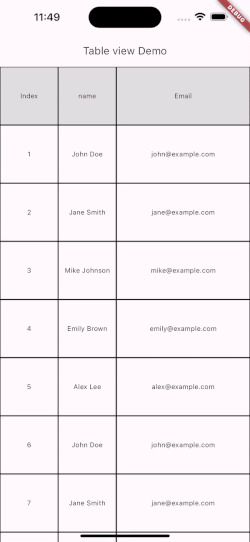 圖片
圖片
固定行和列
固定持續(xù)出現(xiàn)在 TableView 視口邊緣的特定數(shù)量的行和列。
TableView.builder(
...
pinnedRowCount: 1,
pinnedColumnCount: 1,
),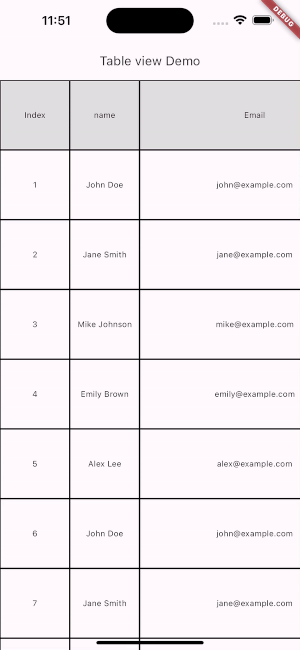 圖片
圖片
滾動(dòng)細(xì)節(jié)
ScrollableDetail 允許對(duì)小部件的垂直和水平滾動(dòng)行為進(jìn)行特定配置。
verticalDetails: ScrollableDetails.vertical(
reverse: true,
controller: verticalController,
physics: const AlwaysScrollableScrollPhysics(),
decorationClipBehavior: Clip.hardEdge
),ScrollableDetails 中的 verticalDetails 允許對(duì)小部件的垂直滾動(dòng)行為進(jìn)行特定配置,它封裝了各種屬性。
verticalDetails: ScrollableDetails.vertical(
reverse: true,
controller: verticalController,
physics: const AlwaysScrollableScrollPhysics(),
decorationClipBehavior: Clip.hardEdge,
)以下是屬性的詳細(xì)說明:
- reverse :當(dāng)設(shè)置為 true 時(shí),小部件內(nèi)的內(nèi)容向相反方向滾動(dòng)。
- controller :指定用于管理和控制滾動(dòng)行為的 ScrollController 。它允許您滾動(dòng)到特定位置或收聽滾動(dòng)偏移量的變化。
- physics :確定滾動(dòng)物理的行為。
- decorationClipBehavior :指定可滾動(dòng)區(qū)域裝飾的剪切行為
cacheExtent 緩存范圍
cacheExtent: 200,與ListView類似, cacheExtent 是在進(jìn)入屏幕可見部分之前繪制的區(qū)域的大小。
DiagonalDragBehavior 對(duì)角線拖動(dòng)行為
該枚舉允許開發(fā)人員指定如何使用 kTouchSlop 處理對(duì)角滾動(dòng)。
結(jié)論
在本教程中,我們學(xué)習(xí)了如何使用 Flutter 中的 two_dimensional_scrollable 實(shí)現(xiàn) Flutter 中的 tableView,我們可以用它做更多的事情并使用它添加更多功能。這是我對(duì) Flutter 中 TableView 的一個(gè)小介紹。
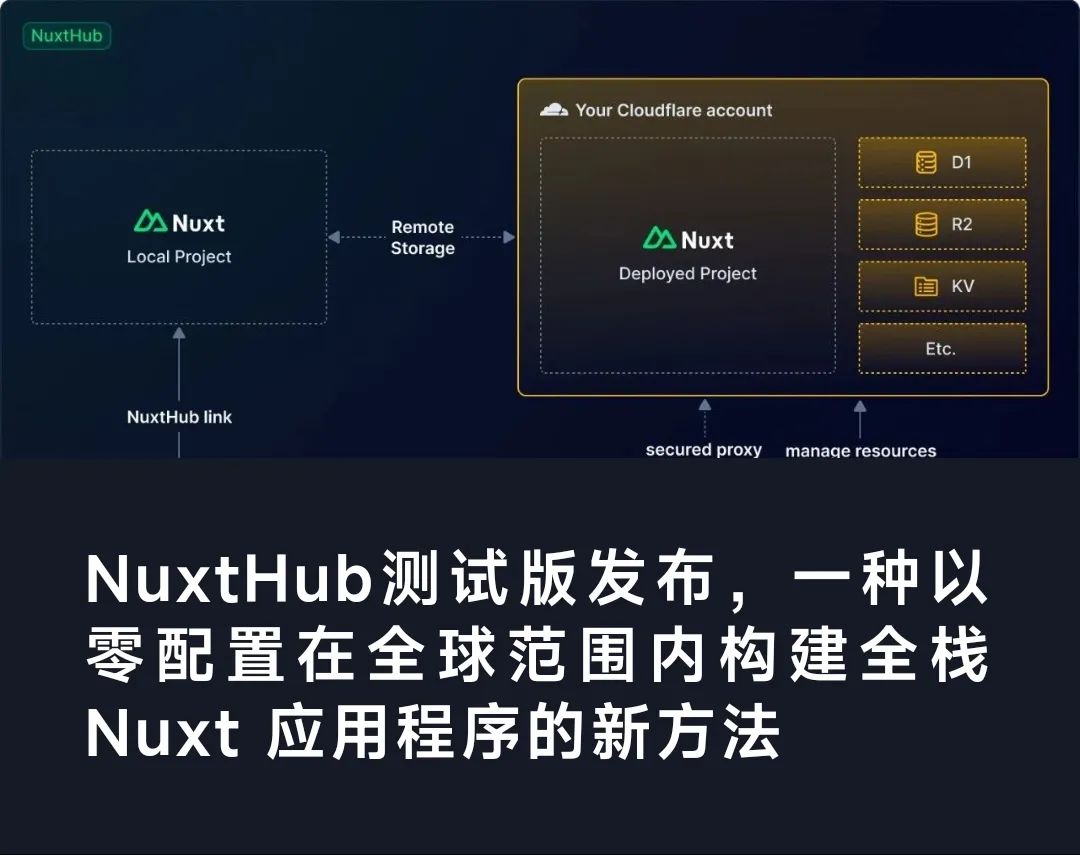 翻譯自:https://blog.canopas.com/how-to-implement-2d-scrollable-tableview-in-flutter-a8b0fe703614圖片
翻譯自:https://blog.canopas.com/how-to-implement-2d-scrollable-tableview-in-flutter-a8b0fe703614圖片
參考資料:
[1]這里: https://gist.github.com/cp-sneha-s/d2375b2a624f5650fa3836a84805b15f




































